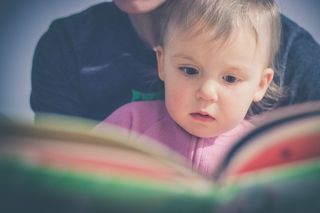Child Development
E-books for Young Children, Blessing or Bane?
Are e-books as helpful to read with young children as traditional print books?
Posted February 26, 2018

Shared reading—that is, reading books out loud to and with younger children—is one of the very best ways to start them on the path to lifelong literacy, as shown by decades of research. But most of that research was conducted using traditional print books, while e-books now form a significant part of the children’s book market.
So, are e-books better or worse to read with young children than traditional print books? Researchers in this relatively new area have found conflicting results, in part because e-book technology has changed significantly over the past decade. Rather than giving a simple Yes or No answer, it seems better to consider how, when, and what kind of e-books might be more or less helpful in furthering young children’s reading development.
E-books can offer children and parents access to more, and more diverse, books
We have long known that children who have access to more books at home are more likely to become good readers. On the 2000 Program for International Student Assessment (PISA) tests, the literacy learning effects of having more books in the home were highly significant across all 44 countries, both developing and advanced.
But books can be expensive, and busy parents don’t always have time to get to the library. Fortunately, there are many free children’s e-books available online. Two of our favorite free sites are The International Children’s Book Library, which contains hundreds of free e-books for children of all ages, written (and sometimes translated) in multiple languages, and Unite for Literacy, which also offers hundreds of free digital picture books, written in English or Spanish, with audio read-aloud translations in 38 languages. Either of these might be especially helpful for parents who are English language learners. Or consider Storyjumper, which not only features free picture e-books to read, but offers parents and children the chance to create their own free customized e-books. As long as they have any kind of internet-enabled device (including a smartphone), sites like these offer parents short on time or money access to a huge "home library" of e-books to read with their children.
E-books can grab children’s interest
Because such a wide selection of e-books are now available for children, parents can almost guarantee finding something that will appeal to the personal interests of almost any child. Many e-books also have added features to engage children’s interest, like buttons to push or read-aloud or music or even additional book-related activities that parents and kids can do together. Such features may be especially helpful for a child that has trouble holding still long enough for a traditional “storytime.” In a study published in 2013, Julia Parish-Morris and her colleagues found that parent-child pairs who read electronic books with such features spent much longer reading and interacting around the books than did those who read the same stories in traditional print format. A 2009 study by Segal-Drori and colleagues similarly found that emergent readers who read such interactive e-books with adult partners learned more about concepts of print and word identification, compared to those who jointly read the same stories, but in traditional book format.
Some cautions
Both of these same studies, however, suggest a few important cautions about e-books for young children.
Since most e-book programs (like Amazon’s Kindle and Apple’s iBooks) can be set to read books aloud, it may be tempting for busy parents to just let the device do the reading. But children in Segal-Drori’s study who used this feature to access the e-books, without adult human interaction, did not benefit from the experience in the same way as those who read the e-books along with an adult.
There may also be some disadvantages to all those engaging, extra features in e-books. In their study, Parish-Morris and colleagues found that, even though they had spent less time reading, children who had read the traditional print book with their parents actually remembered the story better than those who had jointly read the e-book version. They hypothesized that too many distractions from music, sounds, and buttons in the e-books may have interrupted the flow of the story, and thus impaired children's comprehension, while at the same time keeping them engaged longer in the joint reading.
A 2016 synthesis of research that compared reading e-books to print books with preschoolers found similarly mixed results. Most of the studies reviewed found that children could understand books equally well in either format, but adult interaction was still fundamental to getting the maximum benefits. Furthermore, several studies confirmed that excessive or poorly integrated animations or audio effects could be detrimental.
The bottom-line?
E-books can be a great resource for shared reading, offering the possibilities of engaging sound and music, free books, books in many languages, and even self-authored picture books. But the focus needs to remain on the words and ideas, not the bells and whistles, which need to be used as an addition to, not a substitute for, the vital human interactions that occur during shared reading. As with everything related to child development, caring and interactive adults are the key.
References
Parish‐Morris, J., Mahajan, N., Hirsh‐Pasek, K., Golinkoff, R. M., & Collins, M. F. (2013). Once upon a time: Parent–child dialogue and storybook reading in the electronic era. Mind, Brain, and Education, 7(3), 200-211.http://citeseerx.ist.psu.edu/viewdoc/download?doi=10.1.1.693.8182&rep=rep1&type=pdf
Segal-Drori, O., Korat, O., Shamir, A., & Klein, P. S. (2010). Reading electronic and printed books with and without adult instruction: Effects on emergent reading. Reading and Writing, 23(8), 913-930.


